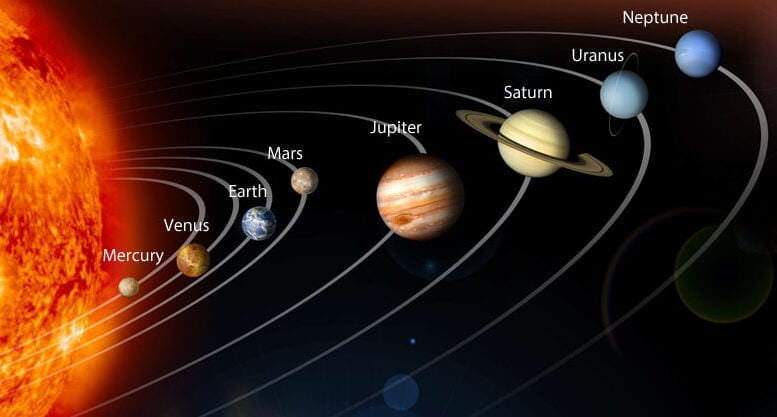There are several gas giants in the solar system that astound with their enormous size. These include Jupiter, Saturn, Uranus, and Neptune. In comparison, our Earth appears insignificant. However, which planet in the solar system holds the title for being the biggest? Undoubtedly, it is Jupiter, which was aptly named after the chief god of the ancient Romans. Moreover, it is 2.5 times more massive than all the other planets combined, even if you were to stack them all against Jupiter alone.
Which planet is the largest in our solar system?
Jupiter, a colossal gas giant, holds the title for being the largest planet in our solar system. Occupying the fifth position in the planetary lineup, Jupiter’s orbit lies beyond Mars and the asteroid belt.
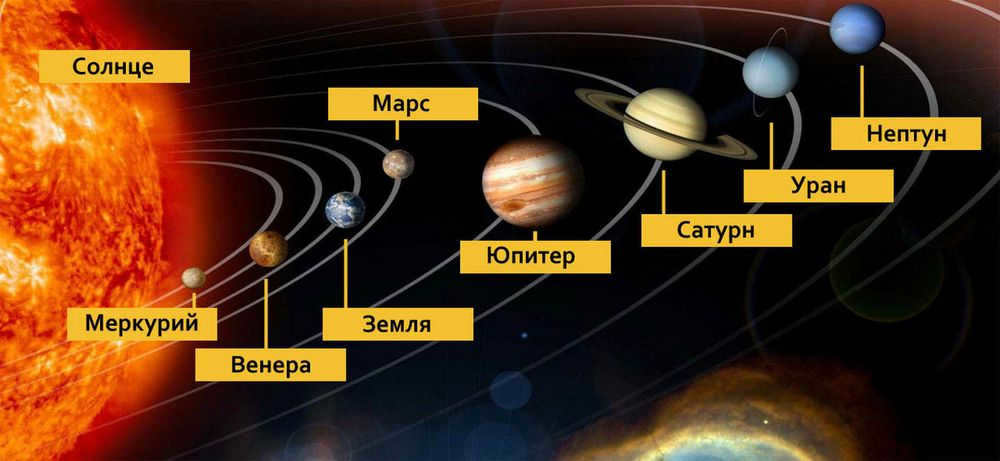
The diameter of Jupiter at the equator measures 143,000 kilometers, which is 11 times larger than Earth’s diameter of 12,742 kilometers. While the other gas giants are also massive, they are considerably smaller. Saturn, the second largest planet, has a diameter of 120,000 kilometers, which is two Earth diameters smaller.
Jupiter’s mass is incredibly huge, weighing in at 1.9 * 10^27 kg. To put this into perspective, imagine 318 Earth planets stacked on top of each other – their combined weight would equal that of one Jupiter. However, the Sun is even larger, weighing as much as 1,050 Jupiters.
The size of the largest planet is 122 times greater than that of Earth. However, it is important to note that the concept of a surface on Jupiter is not applicable due to its composition. As one descends deeper into the planet, the gaseous atmosphere gradually becomes denser, transitioning into a liquid and eventually a metallic state.
Nevertheless, Jupiter is only the largest planet within our solar system. Scientists have discovered a planet, HAT-P-32b, in the Andromeda constellation, which is twice the size of Jupiter.
Jupiter’s Moons
Jupiter is not alone – it is surrounded by numerous moons orbiting around it. Currently, there are 79 known moons, each with its unique shape and size. Among them, Ganymede stands out as the largest moon in the entire solar system. Additionally, there are also several smaller moons that resemble asteroids, appearing as irregularly-shaped fragments of rock or ice.
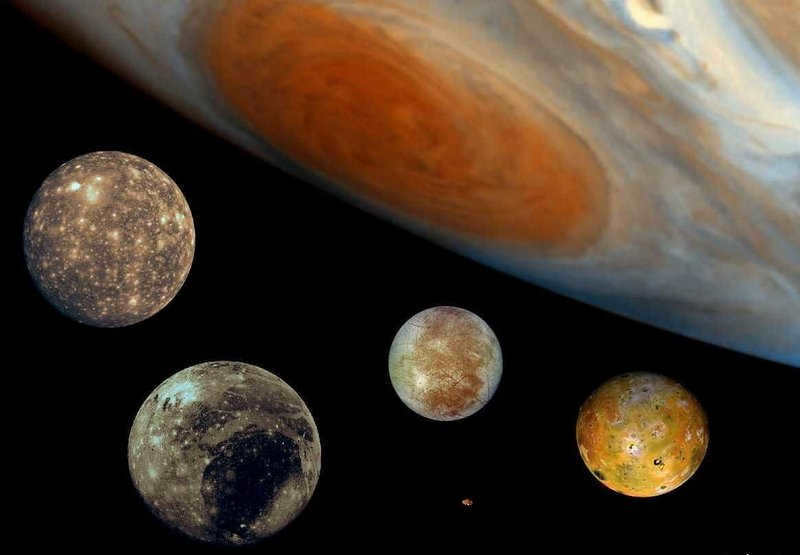
Galileo’s discovery of Jupiter’s satellites.
The most well-known and largest satellites are known as the Galilean satellites, named after Galileo Galilei, the scientist who first observed them. In addition to Ganymede, these satellites include Io, Europa, and Callisto. Even with just a pair of binoculars, one can spot them in close proximity to the planet.

Jupiter, the most massive planet in our solar system, is not only the largest but also possesses a powerful gravitational force that impacts various celestial bodies in its vicinity. This colossal planet has the ability to capture passing asteroids and alter their trajectories, either redirecting them or propelling them back into space. Consequently, the number of Jupiter’s satellites fluctuates over time, with new satellites occasionally being discovered while older ones may vanish, frequently being the smaller ones. Nevertheless, the larger satellites remain in stable orbits, each possessing its own unique characteristics and qualities.
The reason we are able to survive is largely because of the gravitational pull of Jupiter, the largest planet in our solar system. Acting as a protective guardian, Jupiter intercepts the majority of large asteroids and comets that are on a collision course with the inner part of the solar system where Earth is situated. By altering their trajectories, Jupiter ensures that only a small number of these celestial visitors actually reach our planet. Without this crucial intervention, Earth would be at constant risk of global catastrophe and the extinction of life as we know it.
The composition of the atmosphere on the biggest planet in our solar system
Being a gas giant, this planet boasts an incredibly robust atmosphere. Dominated by hydrogen and helium, it is significantly larger than its planetary counterparts. Additionally, traces of methane, ammonia, hydrogen sulfide, and water can also be found in its atmospheric makeup.
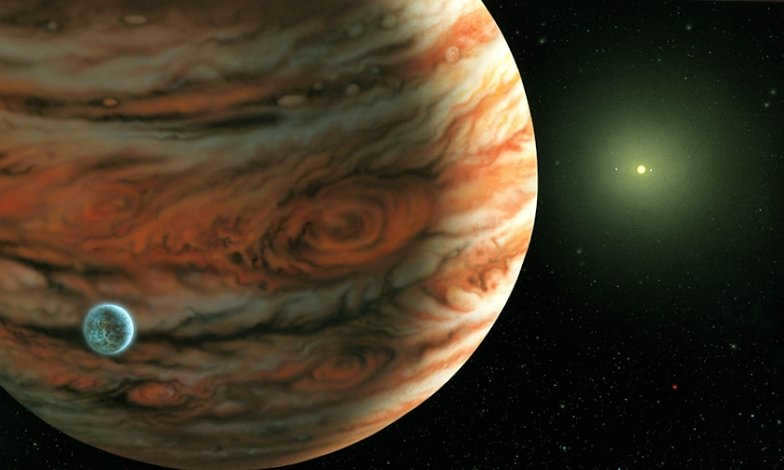
Jupiter’s size in comparison to Earth
Jupiter does not possess a surface in the conventional sense. It is only on Earth that we find air and a solid surface. If we were to descend into Jupiter, we would encounter an immense amount of pressure. Over time, the gas would transform into mist, then into a semi-liquid state, and eventually into a liquid state. As we delved deeper into the ocean of liquid hydrogen, we would witness its compression until it reached a metallic state. However, there is no definitive boundary where this transformation occurs, as the substance transitions through intermediate stages as well. The atmosphere’s boundary lies approximately 5000 kilometers above the hypothetical surface, where hydrogen has already become liquid.
Jupiter’s atmosphere is known for its high turbulence, hosting numerous vortices and hurricanes of various magnitudes. Standing out among them is the Great Red Spot, the largest hurricane in the entire solar system, visible even through a regular amateur telescope. This colossal hurricane has persisted for centuries, although its size has diminished in recent years.
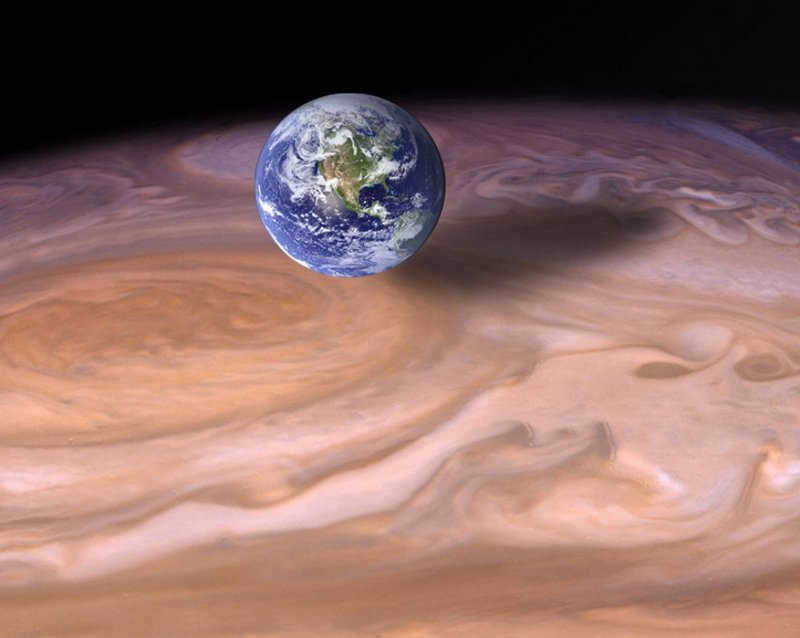
Different sizes of the Great Red Spot on Jupiter can be compared.
The stripes visible on Jupiter are the result of numerous clouds twisted into peculiar spirals by strong winds – these are known as belts and they move in various directions. These clouds are composed of water, ammonia crystals, ammonium sulfide, giving them different colors and positioning them at different altitudes. Moreover, among these clouds, there are powerful lightning bolts that are unparalleled to those found on Earth.
Is it possible for Jupiter to transform into a star?
Jupiter, the largest planet in our solar system, is truly massive. For a considerable period, there was a belief that Jupiter only needed a slight increase in mass for a thermonuclear reaction to occur deep within its core, transforming it into a star. In fact, Jupiter generates more energy, including heat, than it receives from the Sun. However, this phenomenon is a result of the intense compression and immense pressure within its inner layers. This is also the reason behind its turbulent atmosphere.
Over time, Jupiter has been gradually shrinking at a rate of 2 centimeters per year. It is speculated that in the past, Jupiter was twice its current size and significantly hotter. Interestingly, there are now exoplanets that have been discovered and are several times larger than Jupiter.
Jupiter lacks sufficient matter within the solar system to accumulate enough mass. Even if it were to assimilate all the other planets, asteroids, and comets, it would still be unable to attain the necessary quantity. Consequently, Jupiter will forever remain a planet, and an exceedingly large one at that.

The solar system
Our universe is the encompassing entity. It is not a void, but rather a space teeming with a plethora of celestial bodies, including stars, planets, nebulae, galaxies, black holes, pulsars, and quasars.
What lies within our visual range is what we can perceive, courtesy of cutting-edge technological advancements. The visible Universe encompasses all that can be captured using the most potent telescopes. What remains beyond our comprehension and awareness is shrouded in mystery. Nonetheless, we shall now enlighten you about the most immense planets in the solar system.
Mercury
Mercury is a planet in the solar system that is closest to the Sun. It is the smallest planet in our solar system, with a diameter of about 4,879 kilometers. It is named after the Roman god Mercury, who was the messenger of the gods.
Mercury is a rocky planet and does not have an atmosphere like Earth. It has a very thin atmosphere made up of elements such as helium and sodium. Because of its proximity to the Sun, Mercury experiences extreme temperatures, with highs reaching about 800 degrees Fahrenheit (430 degrees Celsius) and lows dropping to about -290 degrees Fahrenheit (-180 degrees Celsius).
Mercury has a very slow rotation, taking about 59 Earth days to complete one rotation on its axis. However, it has a much faster orbit around the Sun, taking only about 88 Earth days to complete one orbit. This means that one day on Mercury is about 176 Earth days long.
The surface of Mercury is covered in craters, similar to the Moon. It also has cliffs and valleys, and some regions are covered in smooth plains. Despite its small size, Mercury has a relatively large iron core, making it the second densest planet in the solar system after Earth.
Mercury has been visited by spacecraft such as Mariner 10 and MESSENGER, which have provided valuable information about its surface and composition. Future missions, such as BepiColombo, are planned to further explore this fascinating planet.
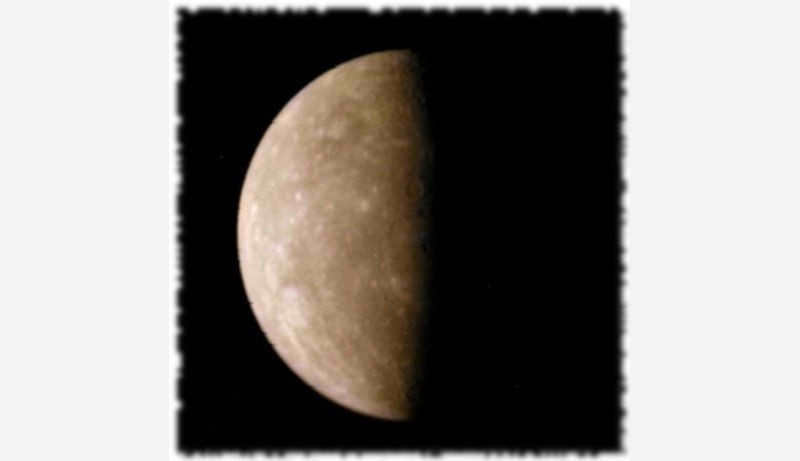
Mercury is the tiniest and nearest planet to the Sun. It has a mass that is only one-twentieth of our planet’s mass, and its radius is approximately two and a half times smaller than Earth’s radius at 2,440 kilometers. With a radius of about two and a half times smaller than Earth’s radius at 2,440 kilometers, Mercury is significantly smaller in size. Despite its small size, it is an incredibly scorching planet. Temperatures on Mercury can soar up to 400 degrees Celsius. This is due to its close proximity to the Sun’s surface. The planet was first extensively explored by the powerful Mariner 10 space probe in 1975.
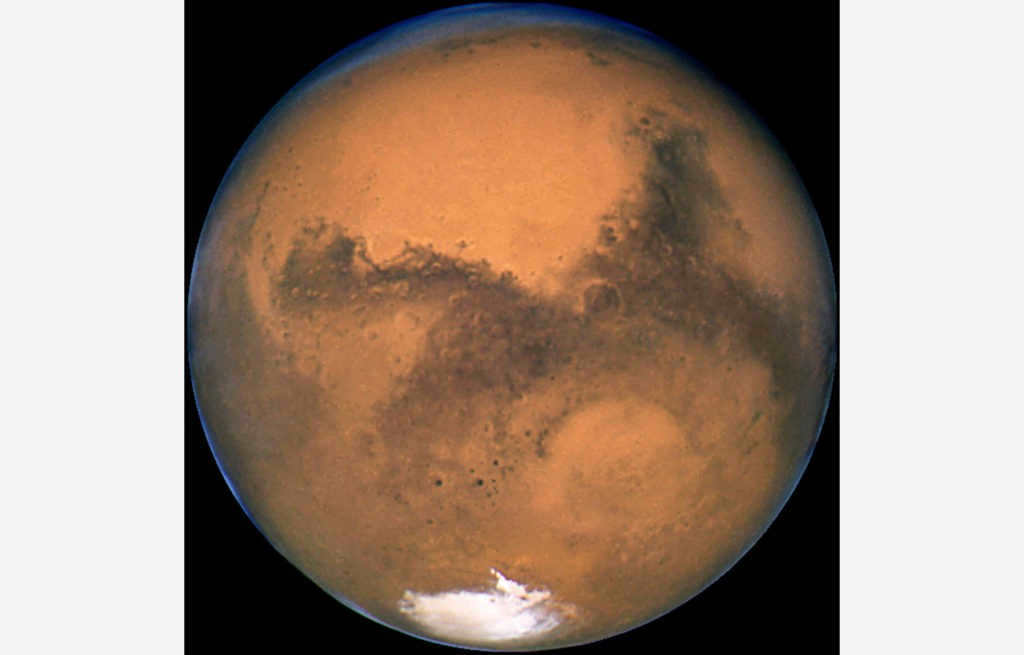
Mars is ranked fourth in terms of its distance from the Sun. It shares a similar age with Earth, estimated to be around four and a half billion years. Scientists have determined that Mars has a radius of 3,390 kilometers, resulting in significantly lower gravity compared to Earth. This reduced gravity provides a more comfortable experience, as individuals can experience a weight loss of up to 60 percent. Additionally, Mars encounters extreme temperature fluctuations. Temperatures at the equator can reach a pleasant 20 degrees Celsius, while the poles experience frigid temperatures as low as minus 120 degrees Celsius.

Venus, the second closest planet to the Sun, was named after the goddess of love and beauty. However, despite its charming name, Venus is an extremely inhospitable place. With a mass that is about 82 percent of Earth’s, Venus is quite similar to our planet. Interestingly, a day on Venus lasts 243 Earth days, while it completes a full orbital rotation in just 225 days. Additionally, Venus has a radius of approximately 6052 kilometers, making it comparable in size to Earth.
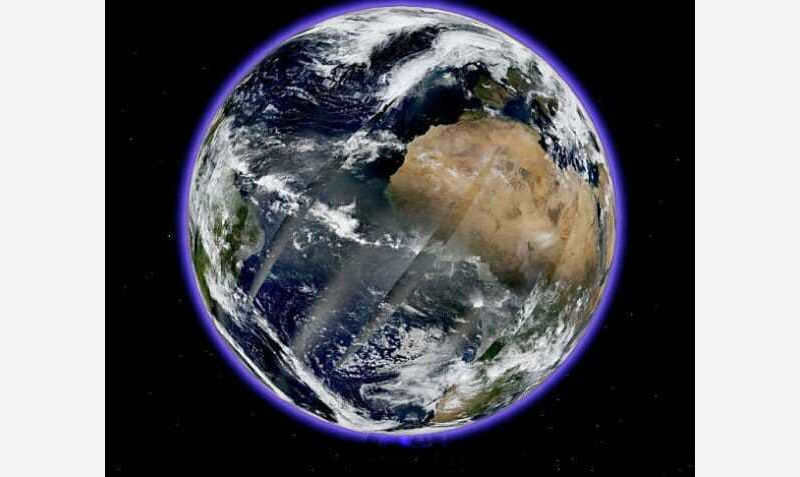
Our planet, Earth, is a unique place that we call home. It is the third planet from the Sun, making it the third farthest. Scientists estimate that Earth is approximately 4.5 billion years old, and they believe it formed from a combination of dust, gas, and small asteroids after the Sun’s formation. While Earth is not the largest planet in our solar system, it is slightly larger than Venus and has an average radius of 6,371 kilometers. One of the reasons Earth is so special is because it is the only known planet in our solar system that is inhabited. This is possible due to Earth’s atmosphere, which supports life. In fact, about 80 percent of Earth’s surface is covered in water.
Neptune
Neptune, named after the Roman god of the sea, is the eighth and farthest known planet from the Sun in the Solar System. It is the fourth-largest planet by diameter and the third-largest by mass. Among the gaseous planets in the solar system, Neptune is the most dense. Neptune is 17 times the mass of Earth and is slightly more massive than its near-twin Uranus, which is 15 times the mass of Earth and slightly larger than Neptune.
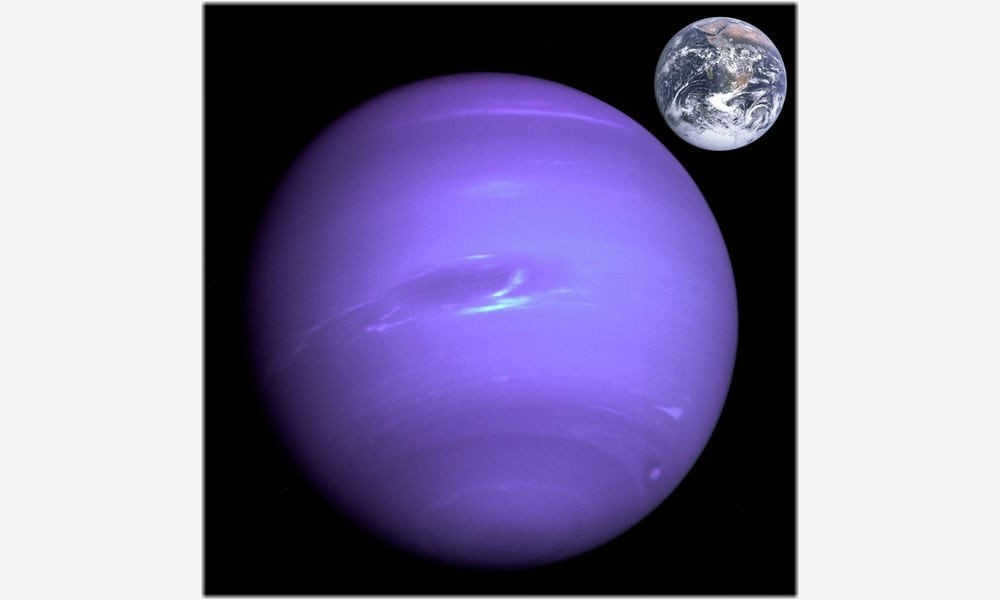
Neptune appears incredibly stunning. The planet’s atmosphere has a striking blue hue and is composed of methane and helium impurities. It was discovered shortly after Uranus was found in 1781. Uranus has a diameter of approximately 49,000 kilometers. Neptune surpasses the size of Earth by a factor of seventeen. Its atmosphere is quite hostile.
In certain regions of Neptune, wind speeds can reach up to six hundred kilometers per hour. The Voyager spacecraft captured unique cloud bands on the planet’s surface. Temperatures on Neptune plummet to minus 220 degrees Celsius, making it a frigid world far from our star.
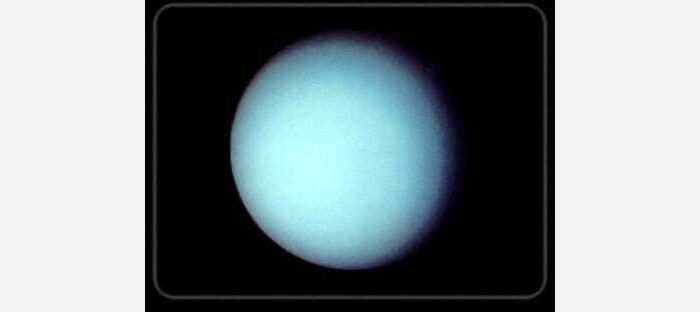
Uranus, a gas giant of significant interest, captures our attention. A genuine frigid celestial body composed predominantly of gas emerges in front of us. Uranus, initially spotted by William Herschel, was discovered in the constellation of Gemini. The Royal Scientific Community of Great Britain was promptly notified of this groundbreaking discovery. The peculiar round shape of the enigmatic entity perplexed the scientist, aligning with the characteristics of a planet.
Originally, Uranus was named “Star George,” but later it was given a name in tribute to one of the Greek deities. Uranus boasts a diameter of 50,000 kilometers, which is four times that of Earth. Additionally, it has a mass fourteen times greater than our planet. Interestingly, Uranus is accompanied by a vast number of moons. There are a total of twenty-seven moons of various sizes orbiting around Uranus. The moons’ diameters range from 1.5 to 20 kilometers.
While Uranus itself is composed of gas, its moons are predominantly comprised of rock and ice. At the core of the planet lies a rocky nucleus encompassed by a solid water layer. The atmosphere of Uranus is predominantly composed of methane and ammonia. The upper atmosphere is a blend of methane, helium, and hydrogen.
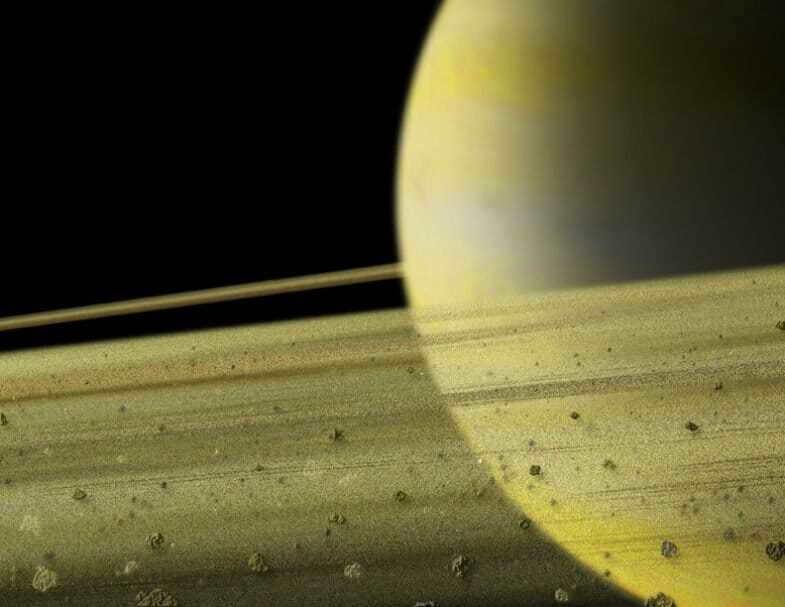
Saturn is not just a large planet, but also a stunning one in our solar system. It was first observed by the renowned scientist Galileo Galilei in 1610. With a diameter of approximately 116,000 kilometers, Saturn is truly remarkable. What makes it even more captivating are its stunning rings, which span a distance of 120,000 kilometers from the planet’s surface. In terms of mass, Saturn is 95 times heavier than Earth.
Out of all the planets in our solar system, Saturn takes the title for being the largest.
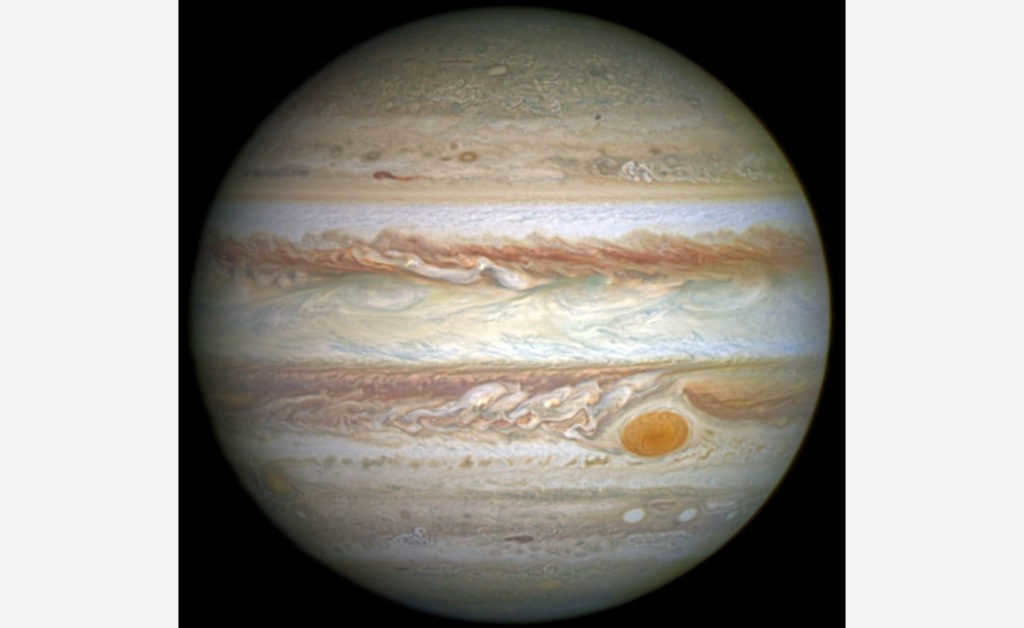
Jupiter is the largest celestial body in our solar system. With a diameter of 142,974 kilometers, it is truly massive. This planet got its name from one of the ancient Roman gods and can be easily spotted from Earth without any special equipment. In fact, Jupiter is so enormous that it could easily fit all the other planets in our solar system inside it. Being a gas giant, Jupiter has an icy atmosphere and extremely low temperatures. Its colossal size also leads to a very fast rotation, with a day on Jupiter only lasting ten hours. This rapid rotation is due to the powerful centrifugal force present at the planet’s equator.
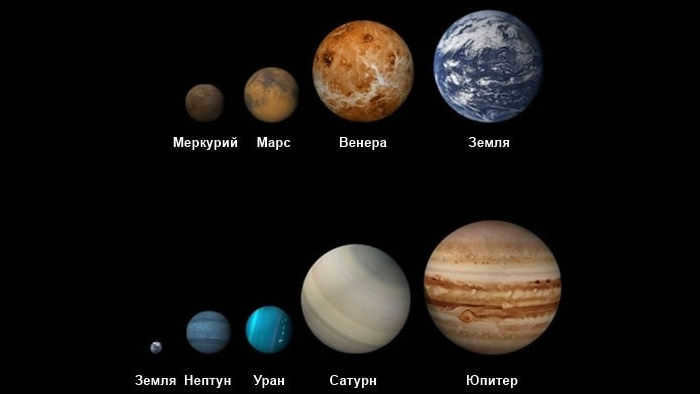
Not only does the planet possess the largest mass and diameter within the solar system, but it also boasts the highest number of satellites. Jupiter is home to a total of sixty satellites that orbit around it. Discovered by Galileo Galilei in 1610 after extensive observations of the celestial body, the four largest satellites are actually comparable in size to Earth. Comprised mostly of hydrogen and helium, Jupiter’s atmosphere is a vast expanse of hydrogen, and its magnetosphere is twenty times more powerful than Earth’s. Additionally, the planet is known for its constant raging storms and hurricanes, which give rise to a prominent red spot on its surface.
If you happen to come across any mistakes, kindly highlight the specific text and hit Ctrl+Enter to notify us.
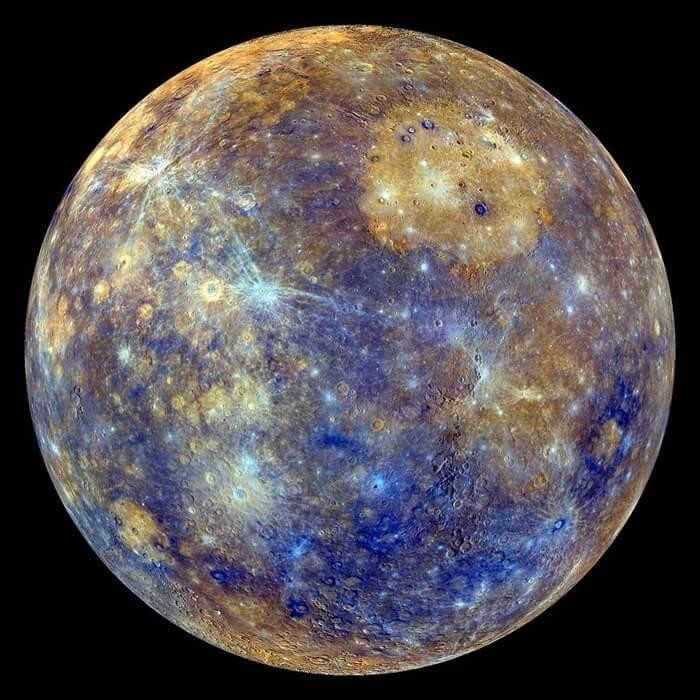
Mercury, the smallest planet in the solar system, is a tiny world with a mass that is nearly twenty times less than Earth’s and a diameter that is 2 ½ times smaller than Earth’s. In fact, Mercury is closer in size to the Moon than it is to Earth. Its rocky surface is covered in craters, giving it a mottled appearance. Recent findings from the Messenger spacecraft have revealed that the deep craters on Mercury’s perpetually shadowed side contain icy water.
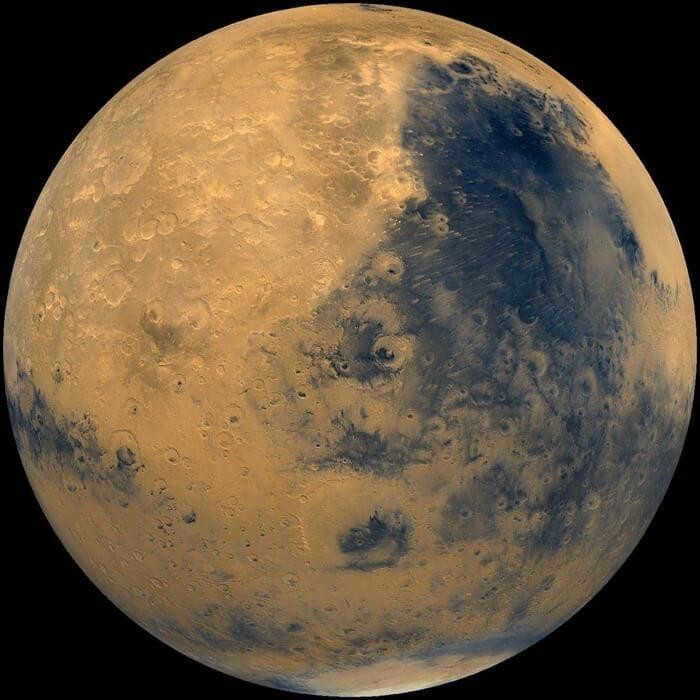
Mars, which has a diameter of 6,792 km, is approximately half the size of Earth. However, it only has a tenth of Earth’s mass. This relatively small planet, which is the fourth closest to the Sun in our solar system, has an axis of rotation that is inclined at a 25.1-degree angle. As a result, it experiences seasons just like Earth does. A day (known as a sol) on Mars lasts for 24 hours and 40 minutes. In the southern hemisphere, summers are hot and winters are cold, while in the northern hemisphere, the contrasts between seasons are not as pronounced and both summer and winter are milder. This makes Mars an ideal environment for constructing a greenhouse and cultivating potatoes.
6. Venus ∼ 12,100 km
6. Venus – approximately 12,100 kilometers
6. Venus: about 12,100 kilometers in diameter
6. Venus measures around 12,100 kilometers
6. Venus has a diameter of roughly 12,100 kilometers
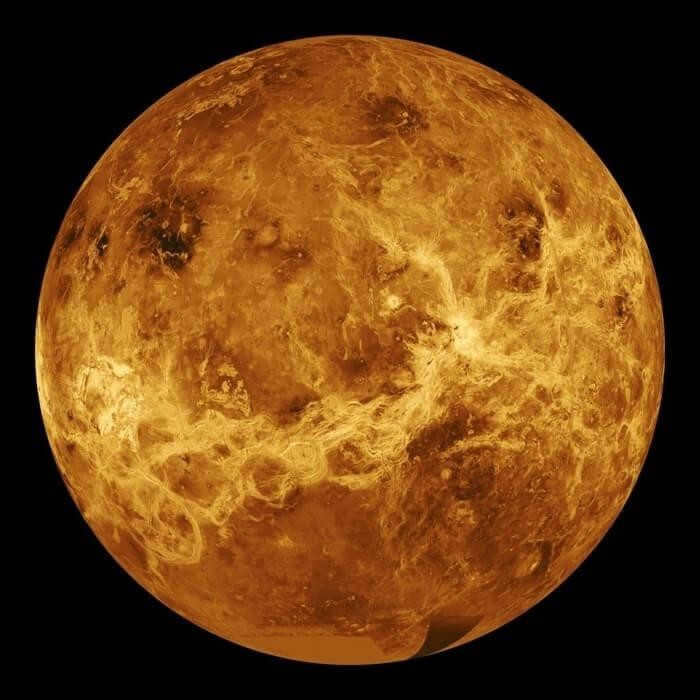
5. Earth – diameter of approximately 12,742 kilometers
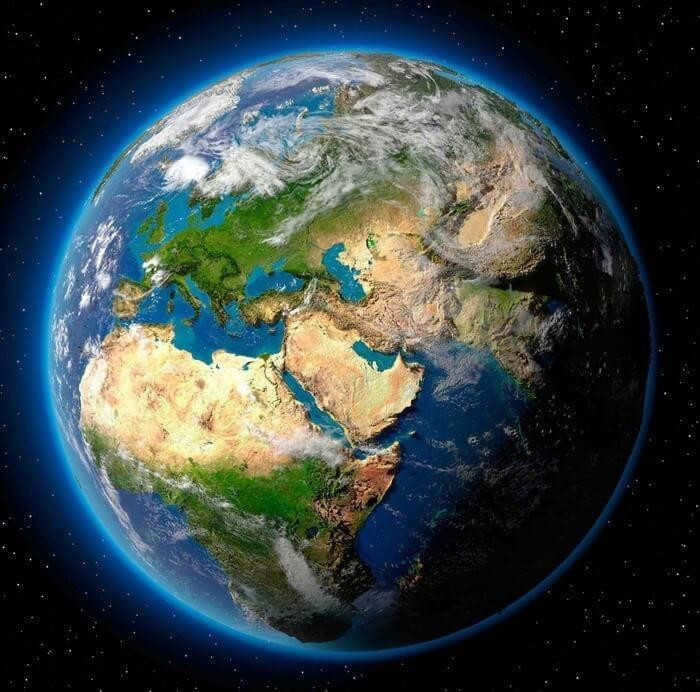
The third celestial body in terms of proximity to the Sun. Earth stands out among the other planets in the solar system for its ability to sustain life. It possesses a tilt of 23.4 degrees on its axis, a diameter measuring 12,742 km, and a mass of 5.972 septillion kg. Our planet boasts an impressive age of 4.54 billion years. Throughout the majority of this time period, Earth has been accompanied by a natural satellite known as the Moon. It is believed that the Moon formed as a result of a massive impact between Earth and another celestial body, Mars, which caused enough material to be ejected, allowing the Moon to take shape. The Moon’s presence has had a stabilizing effect on Earth’s axis tilt and is responsible for the ocean tides.
4. Neptune ∼ 49,000 kilometers
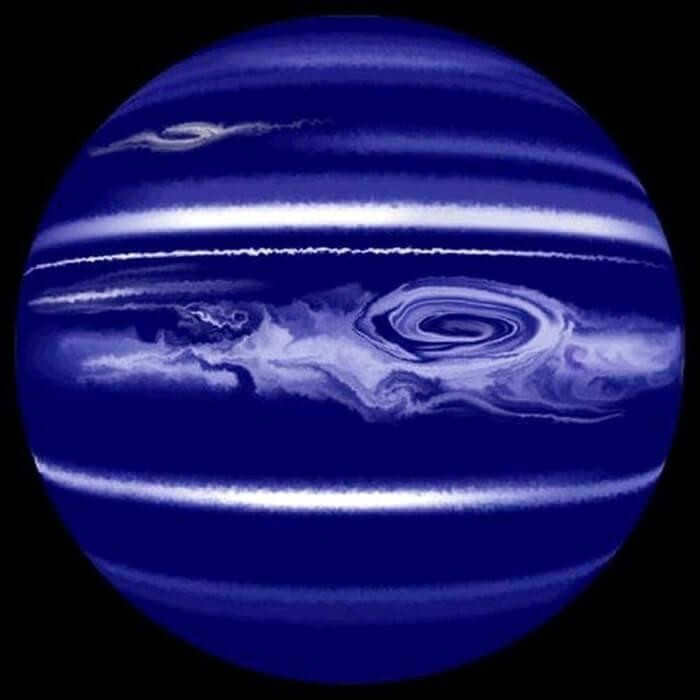
Neptune, the gas giant in our solar system, is the eighth nearest celestial body to the Sun. With a diameter of 49,000 km and a mass 17 times that of Earth, it is one of the largest planets. Voyager 2 captured stunning images of Neptune’s powerful cloud bands, storms, and cyclones. The wind speeds on this planet can reach up to 600 meters per second. Due to its significant distance from the Sun, Neptune is known for its extreme coldness, with temperatures in the upper atmosphere dropping as low as minus 220 degrees Celsius.
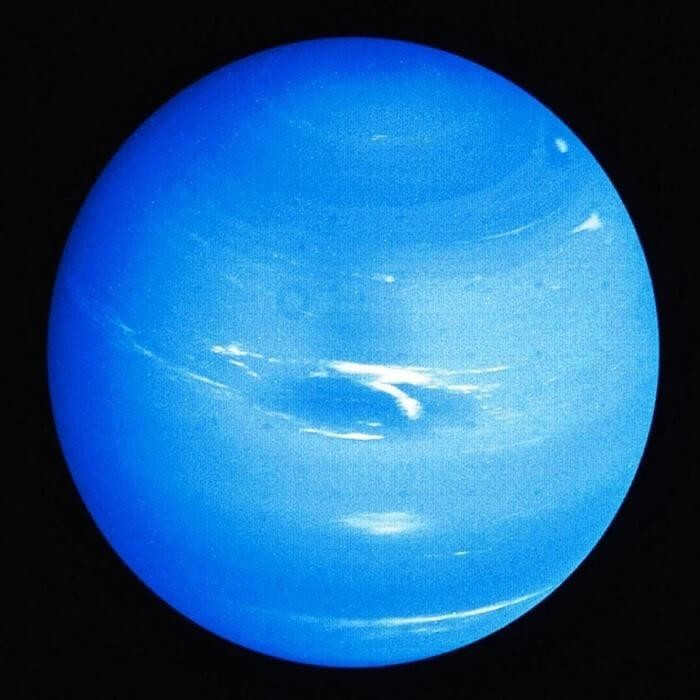
Coming in at number three on the roster of the largest planets in the solar system is Uranus. It holds the title for being the seventh closest planet to the Sun, as well as being the third largest and fourth heaviest in terms of mass. Uranus boasts an impressive diameter of 50,000 km, which is four times greater than that of our own planet, Earth. In fact, Uranus is a whopping 14 times more massive than Earth.
The planet is also home to a remarkable collection of 27 known moons. These moons range in size from over 1,500 km in diameter to less than 20 km. Composed of a mixture of ice, rocks, and other trace elements, these satellites orbit Uranus in a captivating dance.
Uranus itself is comprised of a rocky core that is enveloped by a blanket of water, ammonia, and methane. The atmosphere of the planet is primarily composed of hydrogen, helium, and methane, with a layer of clouds at the very top.
2. The approximate diameter of Saturn is 116,400 km.
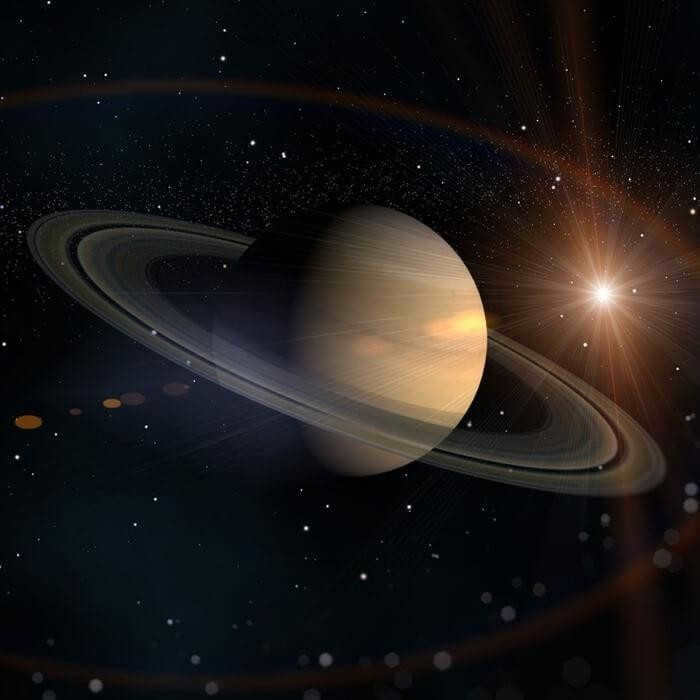
The second largest planet in our solar system is famous for its ring system. This incredible discovery was first made by the brilliant astronomer Galileo Galilei in 1610. Galileo initially believed that Saturn was accompanied by two other planets that were positioned on either side of it. However, it was not until 1655 when Christian Huygens, using an improved telescope, was able to observe Saturn with enough clarity to propose the existence of its magnificent rings. These rings span a distance of 7000 km to 120,000 km above Saturn’s surface. To put Saturn’s size into perspective, its radius is 9 times that of Earth, measuring approximately 57,000 km, and its mass is a staggering 95 times that of our home planet.
The diameter of Jupiter is approximately 142,974 km.
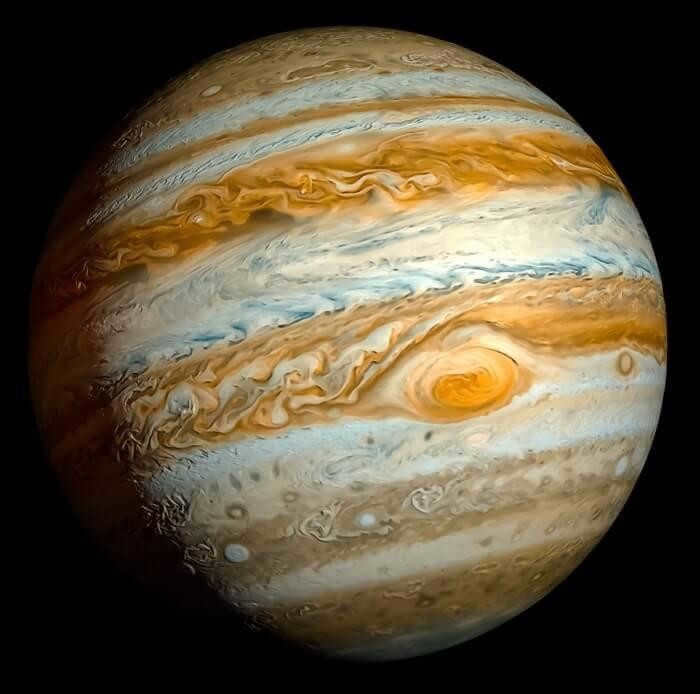
What do we know about Jupiter?
Prior to the telescope’s invention, planets were observed as wandering objects in the sky. This is why the term “planet” translates from Greek as “wanderer”. Our solar system consists of 8 known planets, although initially, 9 celestial objects were classified as planets. In the 1990s, Pluto was reclassified from a true planet to a dwarf planet. Jupiter is the largest planet in our solar system.
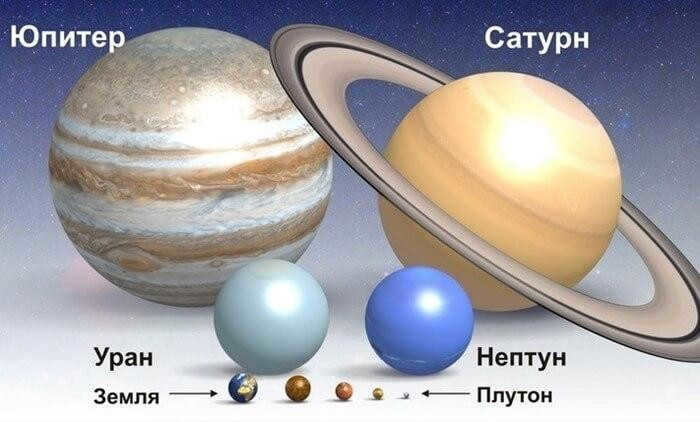
Jupiter’s size in comparison to other planets in the solar system The planet’s radius measures 69,911 kilometers. To put it in perspective, all of the largest planets in our solar system could easily fit inside Jupiter (as shown in the photo). If we were to consider only our Earth, it would take 1300 of them to fill the volume of Jupiter. Positioned as the fifth planet from the Sun, Jupiter takes its name from a Roman god. Composed primarily of helium and hydrogen gases, Jupiter is often referred to as the gas giant of our solar system. The surface of Jupiter is composed of a liquid hydrogen ocean. Furthermore, Jupiter boasts the most powerful magnetosphere among all the planets, measuring a staggering 20,000 times stronger than Earth’s magnetosphere.
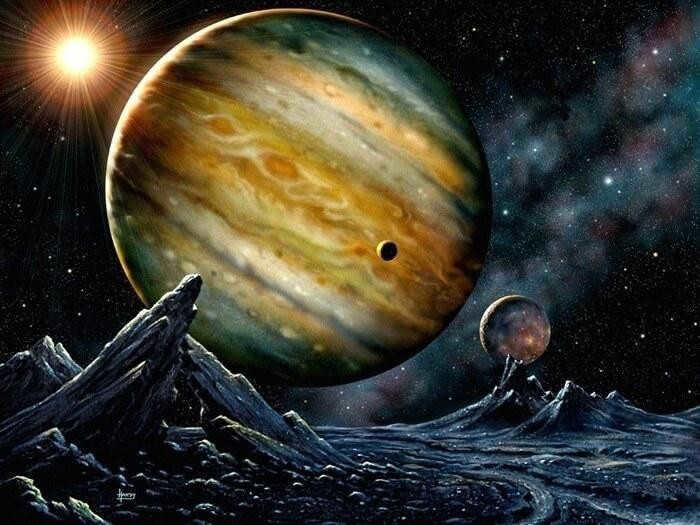
Jupiter, the largest planet in the solar system, rotates faster on its axis compared to other planets. It completes one full revolution in less than 10 hours, while Earth takes 24 hours. Due to its rapid rotation, Jupiter appears bulged at the equator and “flattened” at the poles. The planet’s equatorial diameter is 7 percent wider than its polar diameter. Jupiter, the largest celestial body in the solar system, orbits around the Sun once every 11.86 Earth years.
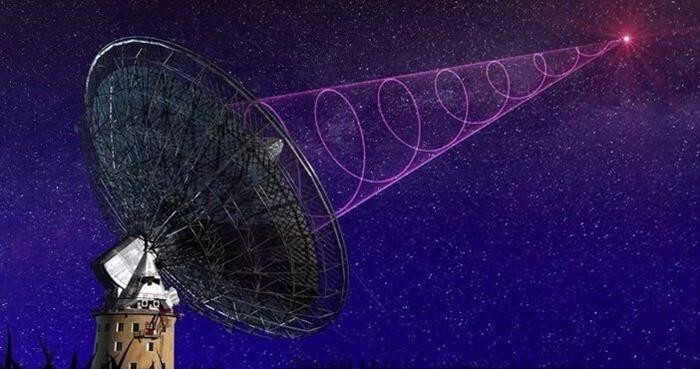
- Jupiter’s magnetic field produces powerful spikes when its closest large moon, Io, passes through specific areas.
- Jupiter emits constant radio waves from its surface and has high-energy particles in its radiation belts. These waves could be used to study the moons of the massive planet and potentially explore their oceans.
The most distinctive characteristic of Jupiter
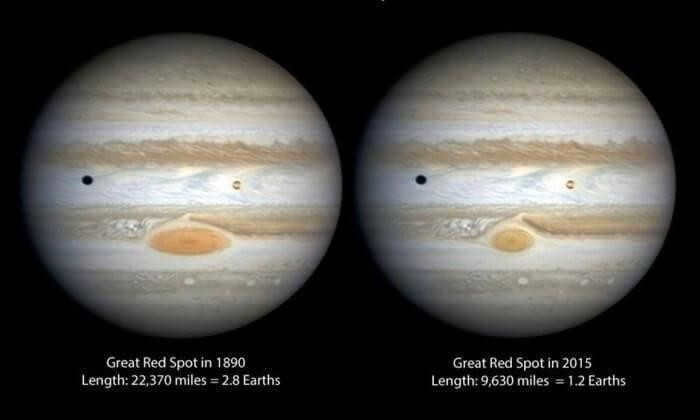
Without a doubt, the most notable characteristic of Jupiter is its extraordinary feature known as the Great Red Spot, an enormous hurricane that has been raging for over 300 years.
- The Great Red Spot is three times the size of Earth in diameter, and its periphery rotates around the center in a counterclockwise direction at an astonishing speed of 360 kilometers per hour.
- The storm’s color, which typically ranges from brick red to light brown, may be attributed to the presence of trace amounts of sulfur and phosphorus.
- The size of the spot fluctuates over time, either expanding or contracting. A century ago, the formation was twice as large and significantly brighter than it is presently.
Jupiter has numerous other storms, but only those in the Southern Hemisphere persist for extended periods of time.
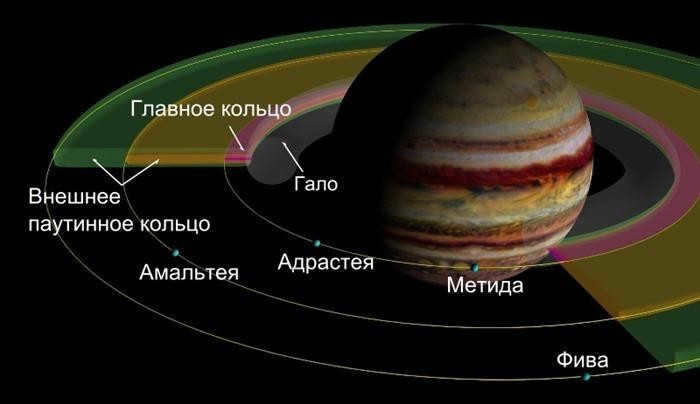
The rings of Jupiter are not as easily visible from Earth as the rings of Saturn, even with small telescopes. It was only through data collected by NASA’s spacecraft Voyager 1 in 1979 that the existence of Jupiter’s rings became known, but their origin remained a mystery. Further data from the Galileo spacecraft, which orbited Jupiter from 1995 to 2003, confirmed that these rings were formed by meteoroid impacts on small satellites orbiting the planet.
Jupiter’s ring system consists of:
- the halo, an inner layer composed of small particles;
- the main ring, which is brighter than the other two;
- the outer “spider web” ring.
The primary ring is compressed, measuring approximately 30 km in thickness and 6400 km in width. The halo stretches halfway downward from the primary ring to the upper regions of the Jupiterian clouds and expands through its interaction with the magnetic field of the planet. The third ring is commonly referred to as the spider ring due to its translucent appearance.
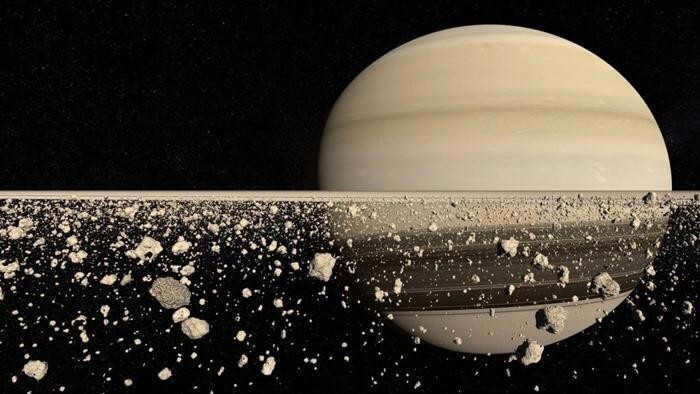
Dust is created when meteorites collide with the small inner moons of Jupiter. This dust then settles into orbit around the planet, forming rings.
The Satellites of Jupiter
Jupiter is orbited by 53 moons that have been confirmed, and an additional 14 moons that are yet to be officially confirmed.
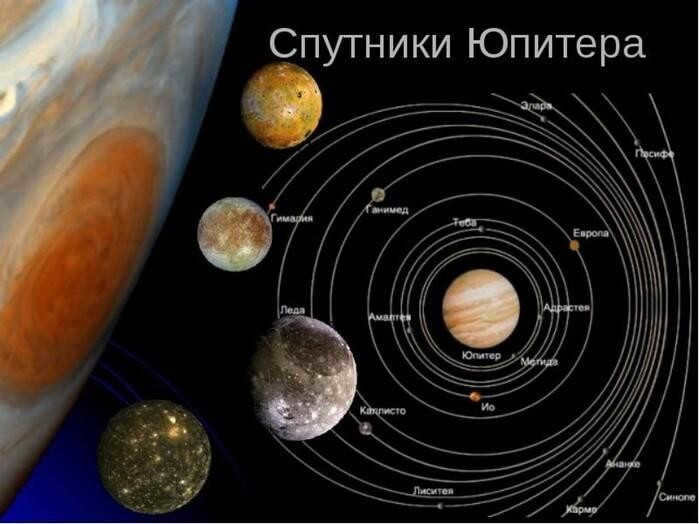
Jupiter, the largest planet in the solar system, is home to four prominent moons known as the Galilean satellites. These moons, Io, Ganymede, Europa, and Callisto, were first observed by Galileo Galilei in 1610. They are named after the companions of Zeus, the Greek god who is equivalent to the Roman god Jupiter.
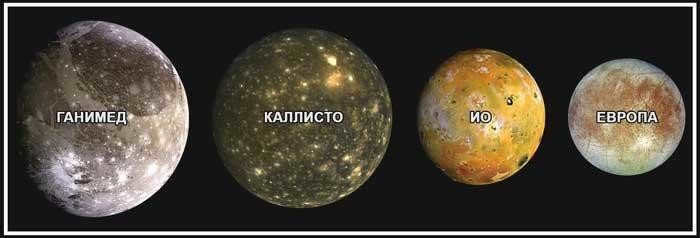
Raging volcanoes can be found on Io; Europa is known for having an under-ice ocean that could potentially harbor life; Ganymede, the largest satellite in the solar system, possesses its own magnetosphere; and Callisto, one of the Galilean satellites, has the lowest reflectivity. It is believed that the surface of this moon is composed of dark and colorless rock.

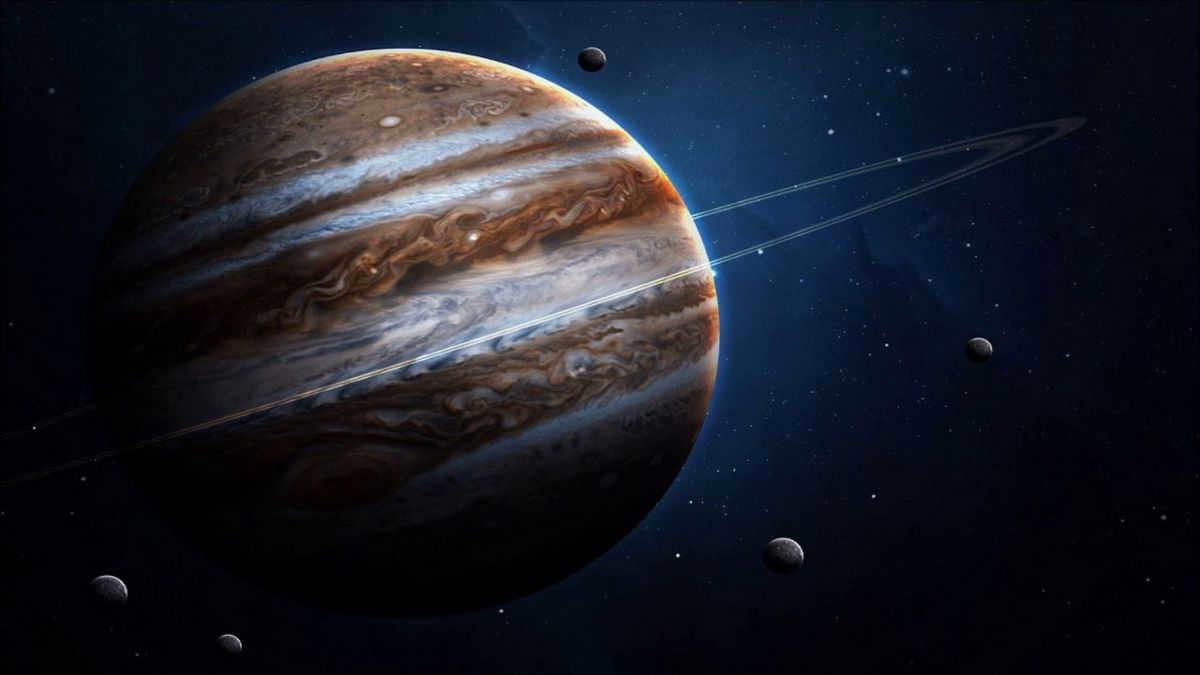
Cosmos
Jupiter, the largest planet in the solar system, holds the title as the fifth largest planet overall. This celestial body, known as the gas giant, is named after the Greek god Zeus, who was the son of Cronus (Saturn) and the protector of the Roman Empire. Jupiter’s immense size sets it apart from the other planets, as it is at least twice the size of all the planets combined (with a mass 318 times that of Earth). Despite its similarities to stars, Jupiter has not accumulated enough mass to ignite and become a burning star.
The biggest planet in the solar system
Jupiter caused a significant breakthrough in scientific understanding of the cosmos when, in 1610, the renowned Galileo was able to observe the enormous planet’s four massive moons – Io, Europa, Ganymede, and Callisto. This marked the first instance in history of substantial celestial bodies orbiting a celestial object other than Earth. This discovery formed the foundation for the Copernican theory, which challenged the notion that Earth was the center of the universe.
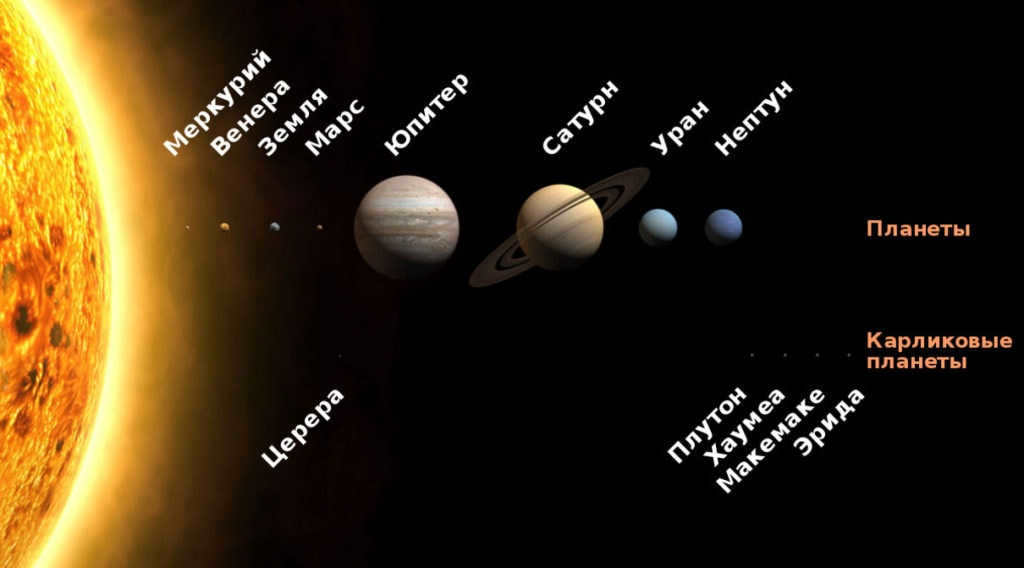
Although it may appear calm from our relatively safe vantage point, Jupiter is a turbulent and chaotic world. The swirling patterns and spots on the gas giant’s surface are the result of violent storms, generating winds that reach speeds of 540 kilometers per hour at the equator – faster than any hurricanes ever recorded on Earth.
However, Jupiter also possesses a mysterious feature in its atmosphere – the Great Red Spot. This powerful storm, known as an anticyclone, is unlike anything our home planet has ever witnessed. It rotates in a constant oval shape that is larger than the entire Earth, although it has been steadily shrinking since its discovery.
Did you know? Jupiter is among the five planets visible to the naked eye when observed at the correct time and location. Additionally, Jupiter ranks as the fourth most luminous celestial body within our solar system. Only the sun, Venus, and the moon outshine it in the night sky.
Jupiter is a captivating planet. Now, let’s examine it more closely.
Composition of Jupiter
Jupiter is an enormous and immensely dense gas sphere that could accommodate all the other planets in the solar system twice over. If Jupiter were just 80 times larger, it would qualify as a bona fide star. The tempestuous giant’s clouds consist of a combination of ammonia and water vapor, suspended within an atmosphere predominantly comprised of hydrogen and helium. It is likely that the unique chemical makeup of these clouds is responsible for the mesmerizing array of pastel colors that adorn Jupiter’s surface. However, scientists have yet to provide a comprehensive explanation for the planet’s intriguing appearance.
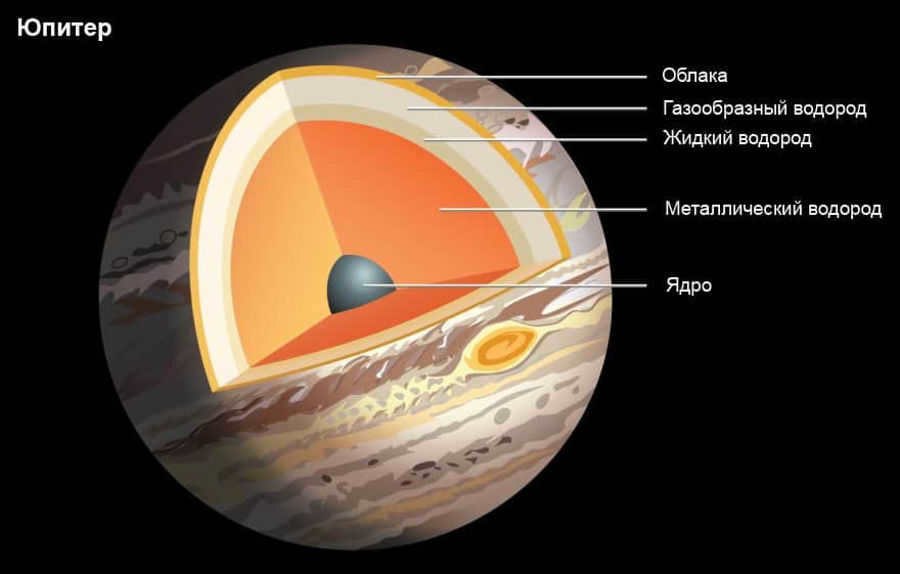
Jupiter’s atmosphere is comparable to that of the sun, primarily composed of hydrogen and helium. The vibrant bands of light and dark are the result of powerful east to west wind currents in the upper atmosphere. The lighter regions contain clouds made up of frozen ammonia crystals, while the slightly darker areas consist of other chemicals. Due to the turbulent nature of this massive planet’s atmosphere, Jupiter’s appearance is in a constant state of flux. At times, the skies are even adorned with showers of precious diamond droplets.
Beneath the gaseous outer layers, the pressure and temperature rise to such extremes that hydrogen atoms are compressed into a liquid state. Jupiter possesses a dense core of uncertain composition, encased by a layer of liquid metallic hydrogen rich in helium, which accounts for approximately 80-90% of the planet’s diameter.
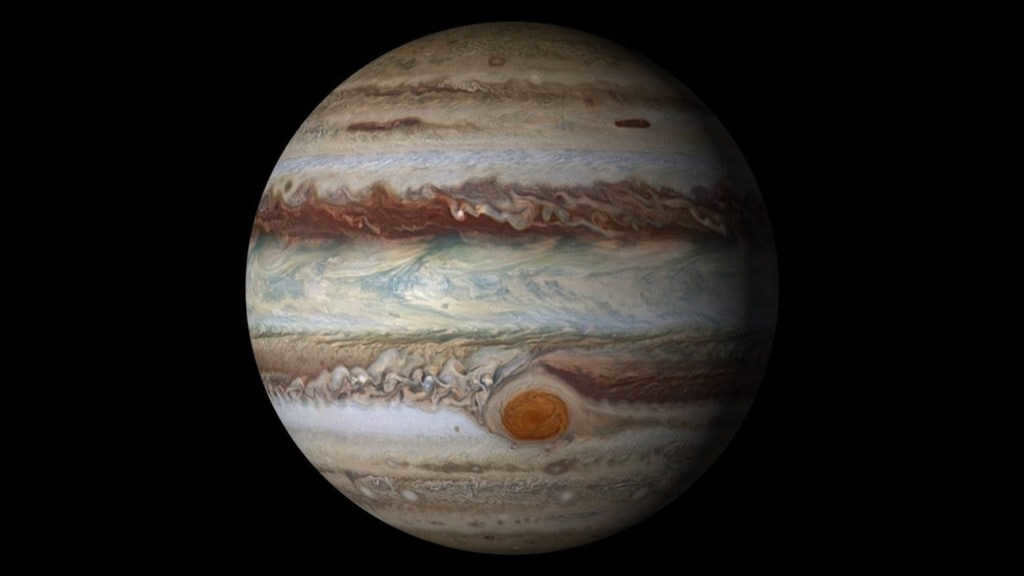
The phenomenon known as the Great Red Spot on Jupiter is arguably the most captivating feature on the planet’s surface. It is a massive hurricane-like storm that has been raging for over three centuries. The wind speeds within the storm can reach an astonishing 680 km/h. The color of the storm varies from a deep brick red to a slightly brown hue, which is believed to be caused by trace amounts of phosphorus and sulfur present in the ammonia crystals found in the storm clouds.
Fascinating piece of information: The presence of a solid surface on Jupiter remains a mystery. Beneath its clouds lie extensive layers of hydrogen and helium, spanning thousands of kilometers. Further down, the hydrogen transitions into a liquid state, eventually transforming into scorching hot liquid metal. The existence of a solid core beneath these layers is yet to be determined, as the extreme temperatures would render any scientific equipment sent to investigate useless. The core’s temperatures are expected to be intense enough to melt even titanium.
The distance of Jupiter from the sun and its orbit
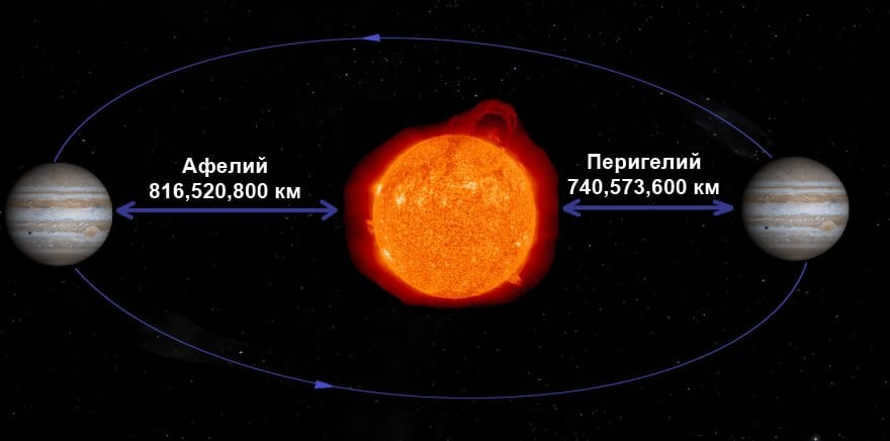
The average distance from the Sun to Jupiter is 778,412,020 kilometers, which is 5,203 times greater than the distance from the Sun to Earth.
Jupiter’s perihelion, or its closest distance to the Sun, is 740,742,600 km, which is 5.036 times greater than Earth’s closest distance to the Sun.
Jupiter’s aphelion, or its farthest distance from the Sun, is 816,081,400 km, which is 5.366 times larger than Earth’s distance from the Sun.
Jupiter holds the record for the highest rotational speed among all the planets in the solar system. The colossal celestial body completes a full rotation in under ten hours. This astonishing velocity has a significant impact on the gas giant’s physical appearance, resulting in a massive bulge located near its equator. Even amateur astronomers with basic telescopes can observe this remarkable phenomenon.
Methods of determining the rotational speed of Jupiter
The rotational velocity of Jupiter’s atmospheric flows varies significantly depending on their latitude. Streams located near the poles rotate approximately 5 minutes slower than those at the equator. To account for these variations, scientists have developed three different systems for calculating the rotation rate.
The first system is used for flows between 10° north latitude and 10° south latitude, where the rotation speed is 9 hours 50 minutes and 30 seconds. The second system applies to all latitudes outside of these boundaries, with a rotation speed of 9 hours 55 minutes and 40 seconds. The third system attempts to combine these approaches by calculating the rotation speed on Jupiter’s magnetic sphere.
Orbiting the Sun
Jupiter completes a full orbit around the Sun in 4328 Earth days, equivalent to 11.86 Earth years, making it one Jupiter year.
Jupiter’s Moons
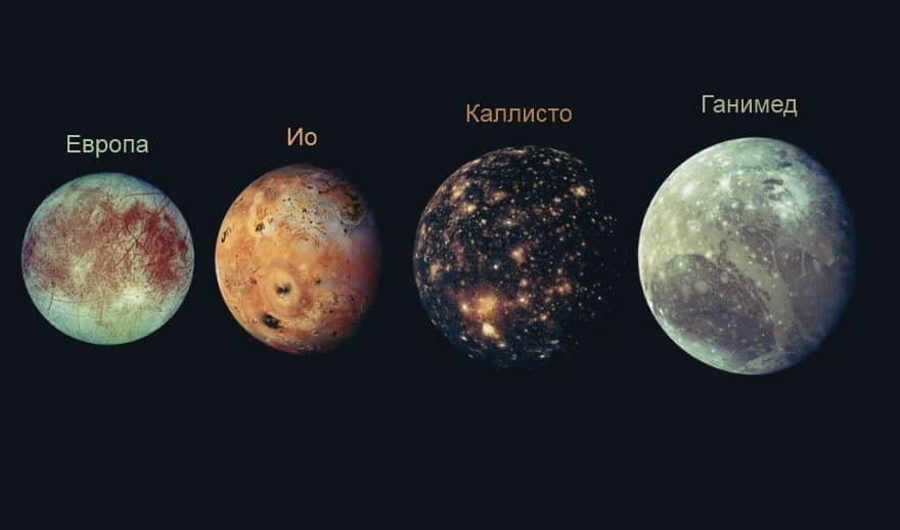

Jupiter is the second brightest celestial body in the night sky after Venus. This allowed scientists to discover and commence studying the vast planet hundreds of years ago. In January 1610, astronomer Galileo Galilei observed what he believed to be four small stars accompanying Jupiter. These fragments of light actually represent the four largest satellites of Jupiter: Io, Europa, Ganymede, and Callisto.
Most of Jupiter’s satellites are equally intriguing and enigmatic as their parent planet. The largest satellite in the entire solar system, Ganymede, is also the sole satellite known to possess its own magnetic field. Io’s surface is teeming with volcanoes, earning it the distinction of being the most volcanically active object in the entire solar system.
However, these four satellites are not the sole ones. Jupiter possesses numerous additional minuscule satellites. In the year 2003 alone, they were capable of detecting as many as 23 novel satellites. Within a single June in 2018, researchers documented an additional 12, which meander along peculiar paths around the splendid planet.
The rings of Jupiter
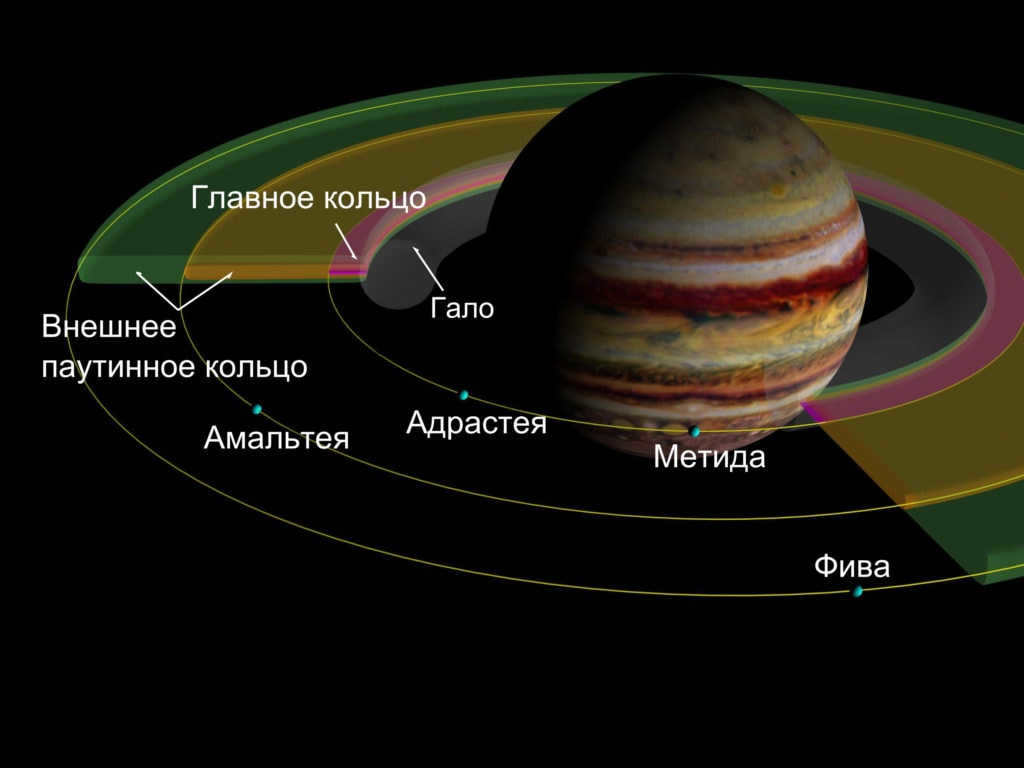

When NASA’s Voyager 1 spacecraft embarked on its mission to study Jupiter in 1979, scientists made a remarkable discovery – the presence of up to three rings around the planet. While not as luminous as Saturn’s rings, these findings provided valuable insights.
The primary ring exhibits a flattened shape, measuring approximately 30 kilometers in thickness and over 6,400 kilometers in width. Complementing this ring is the inner halo, resembling a cloud-like formation, which spans a thickness of 20,000 kilometers. The halo is a result of electromagnetic forces repelling dust particles from the main ring. Originating from the upper atmosphere, this system gradually expands. Both rings consist of minute, obscure dust particles.
The thin ring, also called the third ring due to its transparency, is composed of three separate rings of tiny particles derived from the moons of Jupiter – Amalthea, Thebes, and Adrasteia.
Missions for exploration
Ever since Galileo observed Jupiter, researchers have been conducting studies on the planet, both from the surface of Earth and from space. The initial mission was carried out by Voyager 1, which sent over 10,000 images of Jupiter to scientists while passing by.
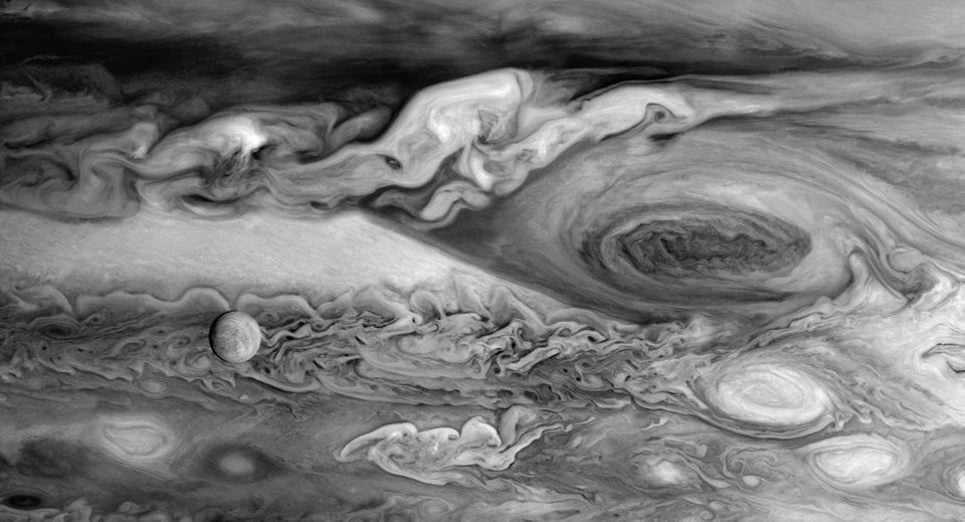
When the Juno spacecraft from NASA entered Jupiter’s orbit in 2016, it immediately started transmitting remarkable photographs. These incredible images unveiled a planet that is even more extraordinary than what we previously believed. “Juno was capable of providing astonishing data that uncovered massive amounts of cyclones circling the surface of the immense planet, with their origins likely extending deep beneath the upper cloud bands.”
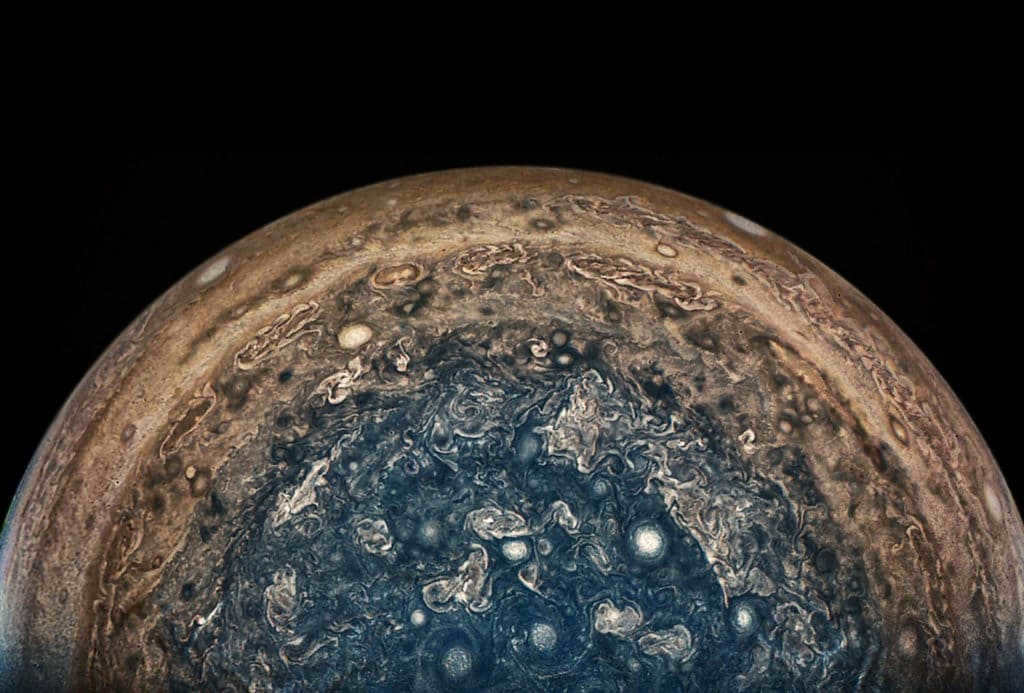
Jupiter has been the target of multiple space missions, and there are at least two more in the works: the Europa Clipper by NASA, set to launch in the 2020s, and the Ice Moons mission by the European Space Agency, scheduled for a 2022 launch and arrival in the Jupiter system by 2030. The Ice Moons mission aims to study Ganymede, Callisto, and Europa.
Can life exist on Jupiter?
Jupiter’s atmosphere becomes warmer as you go deeper, reaching a temperature of around 21°C at an altitude where the atmospheric pressure is about 10 times higher than on Earth. Scientists believe that if there is any form of life on Jupiter, it might only exist at this level, living entirely in the air. However, so far, there is no evidence of life on Jupiter. Satellites are currently the best hope for discovering any signs of life.
Watch this interesting video about the largest planet in our solar system.
If you notice any mistakes, please select the text and press Ctrl+Enter.
The solar system is home to the largest bodies known as giant planets
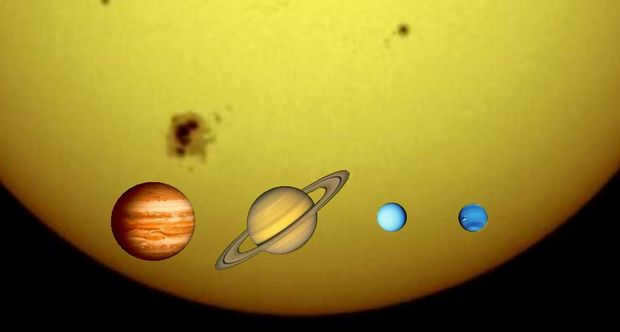
The enormous planets – are the most massive entities in the Solar System after the Sun: Jupiter, Saturn, Uranus, and Neptune. They are situated beyond the Main Asteroid Belt and are thus referred to as “outer” planets.
Jupiter and Saturn are classified as gas giants, meaning they are mainly composed of gaseous substances in solid form: hydrogen and helium.
On the other hand, Uranus and Neptune have been classified as ice giants due to the presence of high-temperature ice rather than metallic hydrogen in their atmospheres.
These colossal planets are significantly larger than Earth, but in comparison to the Sun, their size is relatively small:
According to computer simulations, the presence of large planets in our solar system serves as a crucial defense mechanism against the potential threat of asteroids and comets to the inner planets, including Earth.
Without these giant celestial bodies, the likelihood of our planet being impacted by these space rocks would increase by several hundred times!
So, how exactly do these massive planets shield us from these unwanted visitors?
You may have heard of the phenomenon known as “space slalom,” in which automated spacecraft sent to distant celestial bodies in our solar system execute “gravitational maneuvers” near certain planets. These spacecraft approach the planets along a calculated trajectory and, utilizing the planets’ gravitational pull, gain even more speed without actually colliding with the planets. It’s as if they are propelled forward like a slingshot, but with greater velocity than when they first entered the planet’s sphere of influence. This method conserves fuel that would otherwise be required for acceleration using the spacecraft’s engines alone.
Similarly, the gas giant planets have the ability to launch asteroids and comets out of our solar system. These celestial objects attempt to make their way towards the inner planets, including Earth. However, when they come too close to Jupiter and its fellow gas giants, their speed is increased and they are redirected away from their original path, ultimately flying off into the depths of space.
Therefore, it can be argued that life on Earth would likely be impossible without the presence of these giant planets, as they serve as a protective barrier against constant meteor bombardment.
Jupiter is the largest planet among the giants.
First in line from the Sun, among the giant planets, we find Jupiter. It holds the title for being the largest planet in our solar system.
Some consider Jupiter to be an unsuccessful star. However, it lacks the necessary mass to initiate its own nuclear reactions. Nevertheless, its mass is gradually increasing as it absorbs interplanetary matter such as comets, meteorites, dust, and solar wind. According to one theory about the solar system’s evolution, if this trend continues, Jupiter could potentially become a star or a brown dwarf, transforming our solar system into a binary star system. Interestingly, binary star systems are quite common in the cosmos surrounding us, while solitary stars like our Sun are much more rare.
According to calculations, Jupiter is currently generating more energy than it receives from the Sun, indicating that nuclear reactions may already be occurring within its core. This phenomenon suggests that Jupiter may possess star-like qualities, rather than solely being a planet.
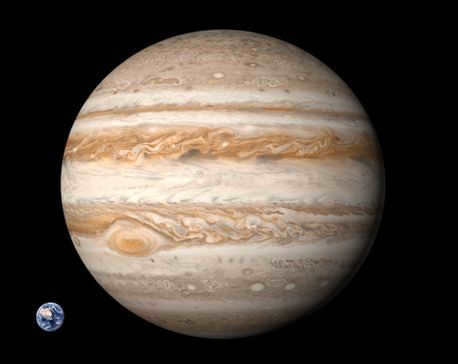
Here is a visual representation of the relative sizes of Earth and Jupiter. It is interesting to note that Jupiter is significantly larger than Earth, with a diameter more than 11 times greater. In addition to its size, Jupiter is also known for its iconic feature, the Great Red Spot. This massive storm, often referred to as Jupiter’s eye, is a swirling vortex that has been observed for centuries.
In 1989, the Galileo spacecraft was launched on a mission to explore Jupiter. Over the course of eight years, it captured unique images of the gas giant itself, as well as its satellites, and collected a wealth of data.
Although we can only speculate about what is happening in Jupiter’s atmosphere and interior, the Galileo probe provided some insights. Descending into the planet’s atmosphere at a depth of 157 kilometers, the probe survived for a mere 57 minutes before being crushed by the intense pressure, which reached 23 atmospheres. However, during its short lifespan, it managed to capture powerful thunderstorms and hurricane-force winds, and transmitted valuable data about the composition and temperature of the planet.
Ganymede, the largest of Jupiter’s satellites, is not only the largest satellite in the Jovian system, but also the largest moon in the entire solar system.
One of the most significant moments in the Galileo mission occurred in 1994 when the spacecraft witnessed the impact of the Shoemaker-Levy comet on Jupiter’s surface. The probe captured and transmitted images of this rare event, which could not be observed from Earth. Only residual effects of the impact became visible as Jupiter rotated.
Saturn: The Ringed Planet
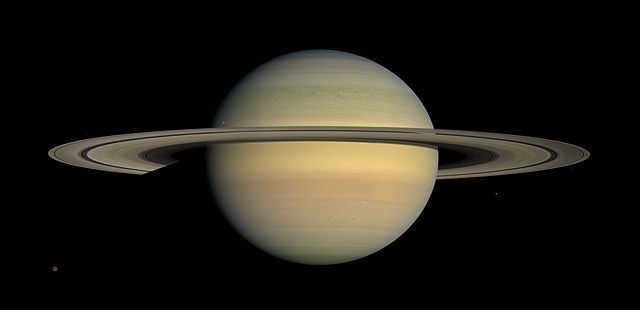
The planet Uranus is classified as an ice giant
Composed mainly of hydrogen and helium, Uranus has an atmosphere that surrounds an interior made up of ice and solid rock. Unlike the turbulent and stormy Jupiter, Uranus appears to be a relatively calm planet, although there have been observations of swirling formations within its atmosphere. While Jupiter and Saturn are referred to as gas giants, Uranus and Neptune are categorized as ice giants due to their lack of metallic hydrogen and abundance of various high-temperature states of ice.
Out of all the planets in the Solar System, Uranus is known for its extremely low internal heat, making it the coldest with a recorded temperature of -224° Celsius. Even Neptune, which is further from the Sun, is comparatively warmer.
Uranus also possesses a number of moons, although they are not particularly large. The largest of these moons, Titania, is more than half the diameter of our own Moon.
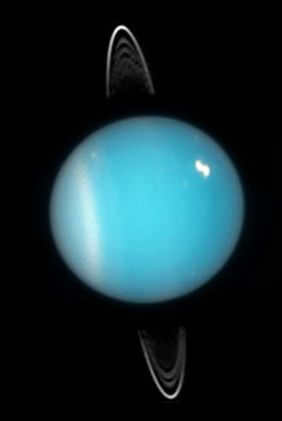
Sorry, I didn’t forget to rotate the image 🙂
Unlike the rest of the planets in our solar system, Uranus is tilted on its side – its axis of rotation is almost parallel to its orbit around the Sun. As a result, its South and North poles face the Sun. This means that one pole experiences a solar day that lasts for 42 years, followed by a 42-year “polar night” when the opposite pole is illuminated.
This photograph was captured by the Hubble telescope in 2005. It showcases Uranus’ rings, the vibrant south pole, and a prominent cloud in the northern latitudes.
It turns out that Saturn is not the only planet to adorn itself with rings!
Interestingly enough, all of the planets in our solar system are named after Roman gods, with the exception of Uranus, which is named after a god from Greek mythology.
What’s even more intriguing is that the acceleration of free fall at the equator of Uranus is only 0.886 g, meaning that the force of gravity on this massive planet is actually lower than that on Earth! This is due to the low density of Uranus, despite its significant mass.
While spacecraft have flown by Uranus and captured images, no comprehensive studies have been conducted yet. However, both NASA and the European Space Agency have plans to send research stations to Uranus in the 2020s, which will provide us with a wealth of new information about this mysterious ice giant.
Neptune
– is the eighth and farthest known planet from the Sun in the Solar System. It is the fourth-largest planet by diameter and the third-largest by mass. Among the gaseous planets in the Solar System, Neptune is the most dense. Neptune is 17 times the mass of Earth and is slightly more massive than its near-twin Uranus, which is 15 times the mass of Earth but not as dense.
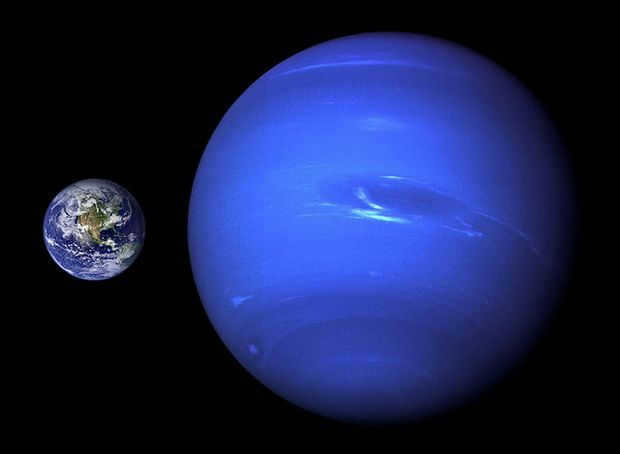
Neptune is the most remote planet in our solar system, following the reclassification of Pluto as a “dwarf planet”. Similar to the other colossal planets, Neptune surpasses Earth in terms of size and mass. Neptune, akin to Uranus, is a massive icy planet.
Neptune, discovered on September 23, 1846, is a unique planet because it was the first to be identified through mathematical calculations rather than direct observation. Astronomers at the Berlin Observatory visually detected Neptune using a telescope, based on the calculations made by French astronomer Leverrier. Interestingly, Galileo Galilei had actually observed Neptune much earlier in 1612, but he mistook it for a fixed star and didn’t realize it was a planet. Therefore, Galileo is not credited with the discovery of Neptune.
In terms of its size and mass, Neptune is quite large, but its density is about 3.5 times less than Earth’s. As a result, the gravity on Neptune’s equator is only 1.14 g, which is almost comparable to Earth’s gravity and the gravity of the two previous giant planets.

